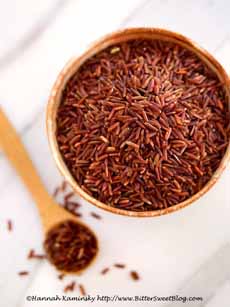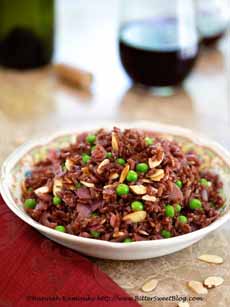TIP OF THE DAY: Bhutanese Red Rice & Pilaf Recipe
|
Bhutanese red rice has been available in specialty stores and online for a decade or more, but most of us haven’t tried it.
With Valentine’s Day around the corner, how about some red rice on your table? It’s a whole grain, high in fiber from its crimson bran. The red color comes from its anthocyanins, flavonoid antioxidants that impart a red, blue or purple color. Red rice cooks much faster than its whole-grain cousin, brown rice, but retains just as much savory, nutty flavor (if not more). Hannah Kaminsky of Bittersweet Blog created this burgundy red pilaf. “Though I could have easily eaten a plain bowlful with a pinch of salt, it would be a shame not to pump up the volume on that ruby rice. “Red wine was a natural pairing, infused right into the grains as they cook to emphasize the deeper, nuttier, grassier notes. “Caramelized onions were a given, although now I’m kicking myself for not adding roasted red peppers as well. Luckily, there will be many more opportunities to paint the dish red.” Ingredients For 4 Servings 1. RINSE the rice with cold water and thoroughly drain. Set aside. |
 [1] Red rice is grown in a variety of rice that is grown in the Kingdom of Bhutan, in the eastern Himalayas. It is the staple rice of the Bhutanese people. Another variety of red rice is grown in the Camargue region of southern France (both photos © Hannah Kaminsky | Bittersweet Blog).
|
|
|
2. MELT the coconut oil in a large saucepan over medium heat and add the onion. Saute for 2 to 3 minutes until translucent, then add the garlic. Turn down the heat to medium low, season with salt and slowly cook, stirring periodically, until caramelized (about 30 minutes). Add the cumin and mustard seeds, lightly toasting for 2 to 3 minutes until aromatic. 3. ADD the red rice, sautéing for just a minute or two. You’re not trying to sear the grains, but to coat them in the oil and aromatics. Deglaze the pan with the red wine and vegetable stock, scraping the bottom to make sure that nothing sticks or burns. 4. ADD the bay leaf and red pepper flakes, cover, and bring to a boil. Reduce the heat to low and maintain a steady, gentle simmer. Cook for 20 minutes, until the rice is tender but still toothsome. Keep covered for 5 to 10 more minutes for any remaining liquid to absorb. 5. STIR in the almonds and peas last, fluff with a fork, and serve while steaming hot. Pilaf is a rice dish cooked in a seasoned broth. In some cases, white rice is sautéed lightly in oil before the addition of broth, to achieve a golden color. Cooked onion, other vegetables, and herbs and spices are added. Depending on the cuisine, a pilaf may also contain meat, fish, pasta and dried fruit. Filling and inexpensive to make, pilafs are popular on every continent. They are variously called pilav, pallao, pilau, pulao, pulaav, palaw, palavu, plov, palov, polov, polo, polu, kurysh, fulao, fulab and fulav. The English word, pilaf, descends from, in turn, the Modern Greek pilafi, the Turkish pilav, the Persian polow and the Hindi pulao, which derives from the Sanskrit pulaka, meaning a ball of rice. Pilaf is an ancient dish. It was served to Alexander the Great at a royal banquet in the 4th century B.C.E. (source). The dish can be humble or ornate, depending on the added ingredients. The earliest known written recipe for pilaf is from a 10th-century Persian scholar, Abu Ali Ibn Sina, who described advantages and disadvantages of every item used for preparing the dish. Persians consider him to be the father of modern pilaf. Pilau became standard fare in the Middle East and the South Caucasus. Over the years, Arabs, Armenians, Persians, Turks and other groups created their own favorite variations. Today, pilafs can be found in the Caribbean, Central and South Asia, East Africa, Greece, the Indian Subcontinent, Latin America and beyond. The next time you cook rice, cook it in a broth, and add some chopped vegetables, spices and herbs!
|
||
